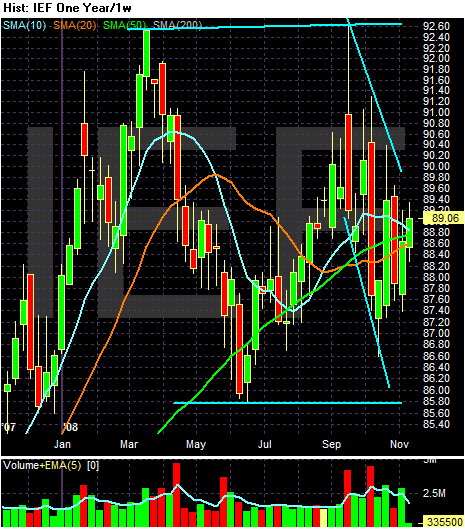Participants turned bearish on 10-year Treasury notes this month for the first time since March, while remaining bullish on government debt from Brazil, France, Germany, Italy, Japan, Mexico, Spain, Switzerland and the U.K., according to the Bloomberg Professional Global Confidence Index. The poll questioned 3,550 Bloomberg users last week.
``The No. 1 reason is supply,'' said Jason Brady, a survey participant and managing director at Santa Fe, New Mexico-based Thornburg Investment Management, which oversees $4 billion in fixed income assets. ``You have Fed and Treasury actions which are supporting credit markets and causing a huge amount of issuance.''
.....
Last week the Treasury Department estimated that it will need to borrow $550 billion this quarter, more than triple an earlier forecast. New York-based Goldman Sachs Group Inc. said Oct. 29 the government's requirement this fiscal year that started Oct. 1 will almost double to $2 trillion.
The federal budget deficit may climb 58 percent to $687.5 billion for fiscal 2009 as U.S. debt swells and the slowing economy crimps tax receipts, according to a survey by the Securities Industry and Financial Markets Association of its members released Oct. 31.
Expectations that yields on 10-year U.S. notes will rise increased to 54.08 in November after reaching a seven-month low of 48.91 in October, according to the Bloomberg survey. The measure is a diffusion index, meaning a reading above 50 indicates that participants expect bonds to weaken and yields to go up.
My central thesis with the Treasury market going forward is we're either going to move sideways or lower. Here's a 1-year chart of the IEF (7-10 year Treasury market) in weekly increments.

Notice the possible formation of a double top with the first top occurring in March and the second top occurring in September (although that top was an intra-week spike). Either way it makes sense for traders to look at this as a double top and trade accordingly.
There are three reasons for the market to move lower.
1.) Inflation: that's contained now.
2.) Increasing rates. That's not going to happen.
3.) Increased supply. We have a big winner with this one. This is what would lead to the increased rates mentioned above.
What's important to remember here is traders are looking at the increased supply as a net negative for the market. This may become constraining from a fiscal perspective at some time. Remember -- the US is already in debt $10.5 trillion dollars.